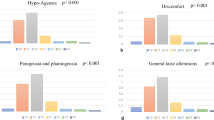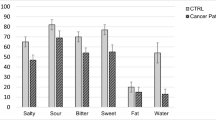Abstract
Purpose
The aim of our study is to evaluate taste changes in patients affected by solid tumors not involving oral cavity within the first month of standard chemotherapy.
Methods
In this monocentric, prospective, cohort study, we enrolled patients treated at our institution for different types of solid tumors between February and July 2019. Taste cotton swabs assay was used to assess taste changes.
Results
Thirty-one patients were enrolled and most of them had at least one change in taste. The taste that changed less was acid (42% of the population) whereas the one that changed the most was the perception of sweet (reduced in 35% of the population and increased in 45% of the population) and sour (reduced in 35% of the population). We did not find any statistical significant difference in terms of changes of taste and type of chemotherapy (emetogenic vs not, p > 0.05 for salty, sweet, bitter, and acid tastes). The type of primary tumor (breast vs GI-related) had a significant impact on perception of both salty (p = 0.0163) and acid (p = 0.0312) flavor. Furthermore, body mass composition assessed by BIA showed that obese patients had different changes in acid flavor vs non-obese patients (p = 0.04). This could not be proven when the assessment was made using BMI calculation.
Conclusions
Our study suggests that type of primary tumor (GI vs breast) more than type of chemotherapy used could be relevant in determining changes in taste during chemotherapy. Individualized dietary strategies based on these reported data are suggested, as to optimize patients’ management.

Similar content being viewed by others
Abbreviations
- NCI CTCAE:
-
National Cancer Institute—Common Terminology Criteria for Adverse Events
- BMI:
-
Body Mass Index
- BIA:
-
Bio-electrical impedance analysis
- GI:
-
Gastrointestinal
- G-CSF:
-
Granulocyte-colony stimulating factor
- GPCR:
-
G Protein-coupled receptor
- MSG:
-
Monosodium glutamate
References
Peterson DE, Boers-Doets CB, Bansadoun RJ, Herrstedt J (2015) Management of oral and gastrointestinal mucosal injury: ESMO clinical practice guidelines for diagnosis, treatment and follow-up. Ann Oncol 26(Supplement 5):v139–v151. https://doi.org/10.1093/annonc/mdv202
Roila F, Molassiotis A, Herrstedt J et al (2016) MASCC and ESMO guidelines update for the prevention of chemotherapy- and radiotherapy-induced nausea and vomiting and of nausea and vomiting in advanced cancer patients. Ann Oncol 27(Supplement 5):v119–v133. https://doi.org/10.1093/annonc/mdw270
Linee Guida AIOM 2019. Neoplasie dello stomaco e della giunzione gastro-esofagea. URL:http://www.aiom.it/linee-guida-aiom-neoplasie -dello-stomaco-e-della-giunzione-gastroesofagea-2019. Accessed 15 Feb 2020
Common Terminology Criteria for Adverse Events (CTCAE) Version 5.0. Published November 27, 2017. Issued by U.S. Department of Health and Human Services. ULR: http://evs.nci.nih.gov/ftp1/CTCAE/About.html. Accessed 15 Feb 2020
Nolden AA, Hwang LD, Boltong A, Reed DR (2019) Chemosensory changes from cancer treatment and their effects on patients’ food behavior: a scoping review. Nutrients. 10
Epstein JB, di Andrade E, Silva SM, Epstein GL, Leal JHS, Barasch A, Smutzer G (2019) Taste disorders following cancer treatment: report of a case series. Support Care Cancer 27(12):4587–4595
Chaveli-Lopez B, Bagan-Sebastian JV (2016) Treatment of oral mucositis due to chemotherapy. J Clin Exp Dent 8(2):e201–e209
Boltong A, Aranda S, Keast R, Wynne R, Francis PA, Chirgwin J, Gough K (2014) A prospective cohort study of the effects of adjuvant breast cancer chemotherapy on taste function, food liking, appetite and associated nutritional outcomes. PLoS One 9(7):e103512
Berteretche M, Dalix A, D'ornano AC, Bellisle F, Khayat D, Faurion A (2004) Decreased taste sensitivity in cancer patients under chemiotherapy. Support Care Cancer 12:571–576
Rehwaldt M, Wickham R, Purl S, Tariman J, Blendowski C, Shott S (2009) Self-care strategies to cope with taste changes after chemioterapy. Oncol Nurs Forum 36(2):E47–E56
Martinez-Cordero E, Malacara-Hernandez JM, Martinez-Cordero C (2015) Taste perception in normal and overweight Mexican adults. Appetite. 89:192–195
Chaudhari N, Roper SD (2010) The cell biology of taste. J Cell Biol 190:28596
Frings S (2010) The sour taste of a proton current. PNAS 107:21955–21956
Kinnamon SC (2013) Neurosensory transmission without a synapse: new perspectives on taste signaling. BMC Biol 11:42
Ravi K (2005) Sweet proteins – potential replacement for artificial low calorie sweeteners. Nutr J 4:5–10
Pritchard TC, Scott TR (1982) Amino acids as taste stimuli. I Neural and behavioural attributes. Brain Res 253:81–92
Ikeda K (2002) New seasonings. Chem Senses 27:847–849
Iwasaki K, Kasahara T, Sato M (1985) Gustatory effectiveness of amino acids in mice: behavioral and neurophysiological studies. Physiol Behav 34:531–542
Nelson G, Chandrashekar J, Hoon MA, Feng L, Zhao G, Ryba NJ et al (2002) An amino-acid taste receptor. Nature 416:199–202
Boughter JD, Pumplin DW, Yu C, Christy RC, Smith DV (1997) Differential expression of α-gustducin in taste bud populations of the rat and hamster. J Neurosci 17:2852–2858
Stone LM, Barrows J, Finger TE, Kinnamon SC (2007) Expression of T1Rs and gustducin in palatal taste buds of mice. Chem Senses 32:255–262
Adler E, Hoon MA, Mueller KL, Chandrashekar J, Ryba NJ, Zuker CS (2000) A novel family of mammalian taste receptors. Cell. 100:693–702
Kikut-Ligaj D, Trzcielińska-Lorych J (2015) How taste works: cells, receptors and gustatory perception. Cell Mol Biol Lett 20:699–716.17
Acknowledgments
This study did not receive any private form of funding and was supported entirely by Ospedali Riuniti di Ancona—Università Politecnica delle Marche. We would like to thank the personnel in the Dietetica e Nutrizione Clinica ward at Ospedali Riuniti di Ancona for having supported the study with the taste strips and the BIA. We would like to thank the patients who decided to participate in the study as well as their families.
Author information
Authors and Affiliations
Contributions
Conceptualization: Riccardo Giampieri, Elisa Pelati, Aurora Anna Mobili, Mirco Pistelli, Marina Taus
Data curation: Riccardo Giampieri, Elisa Pelati, Aurora Anna Mobili, Cecilia Copparoni, Sonia Crocetti, Maria Giuditta Baleani
Formal analysis: Riccardo Giampieri, Cecilia Copparoni, Sonia Crocetti, Maria Giuditta Baleani
Investigation: Elisa Pelati, Aurora Anna Mobili, Sofia Pugnaloni, Sonila Alia, Carlotta Mariani
Methodology: Riccardo Giampieri, Elisa Pelati, Aurora Anna Mobili, Mirco Pistelli, Marina Taus
Software: Riccardo Giampieri
Supervision: Riccardo Giampieri, Rossana Berardi, Marina Taus, Arianna Vignini
Writing—original draft: Riccardo Giampieri, Elisa Pelati, Cecilia Copparoni, Sonia Crocetti, Maria Giuditta Baleani
Corresponding author
Additional information
Publisher’s note
Springer Nature remains neutral with regard to jurisdictional claims in published maps and institutional affiliations.
Electronic supplementary material
ESM 1
List of anti-emetogenic drugs (DOCX 12 kb)
Rights and permissions
About this article
Cite this article
Giampieri, R., Pelati, E., Mobili, A.A. et al. Prospective observational study of taste assay in patients with solid tumors treated with standard chemotherapy (POTATO). Support Care Cancer 29, 851–858 (2021). https://doi.org/10.1007/s00520-020-05553-3
Received:
Accepted:
Published:
Issue Date:
DOI: https://doi.org/10.1007/s00520-020-05553-3




